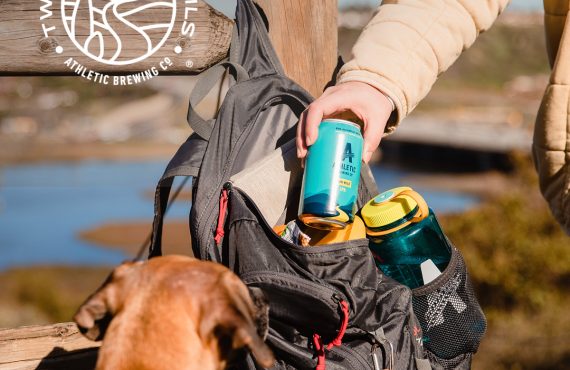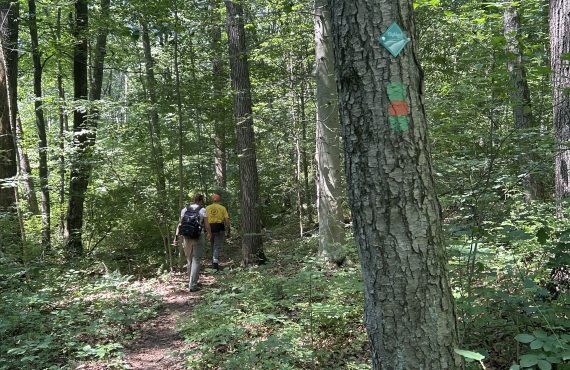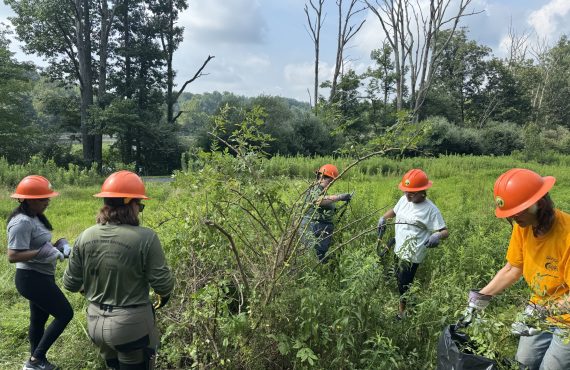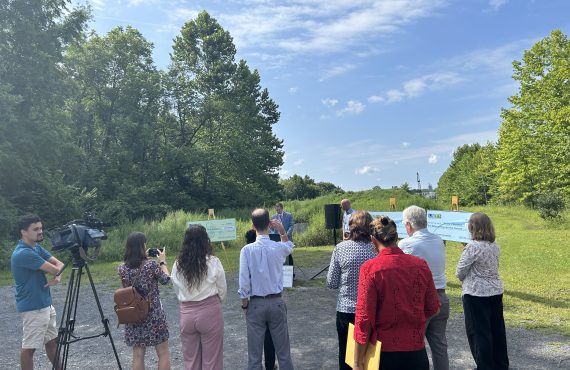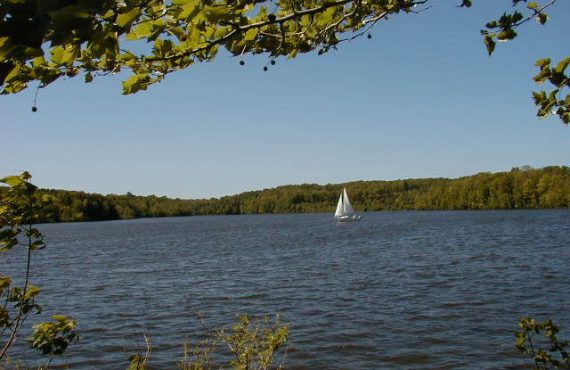News
For events, opportunities, and information about the Pennsylvania Highlands Trail, please click the link below to see the PDF version of the PA Highlands Trail November 2025 Newsletter. PA Highlands Newsletter November 2025
Cheers to Athletic Brewing Company for funding our work! We’re honored to be part of their Two For The Trails program – an initiative that donates up to $2 million annually to help protect, preserve, and maintain local trails and outdoor spaces. This grant will help us rehabilitate the Brickyard Pond Trailhead on Heller Road in Richland Township, a popular fishing spot and Pennsylvania Highlands Trail access point. Keep an eye out for exciting volunteer opportunities relating to this project in the early spring! The Appalachian Mountain Club looks forward to collaborating with Richland Township.
Earlier this month, Congressman Ryan Mackenzie joined non-profit partners from the Appalachian Mountain Club, Wildlands Conservancy, and the Delaware and Lehigh Nation Heritage Corridor at Wildlands Conservancy’s South Mountain Preserve. The group hiked throughout the property to share their work on conservation in the Lehigh Valley. The Land and Water Conservation Fund (LWCF) was of special note as funding from that grant program was used to purchase Allentown’s Reservoir Park, which borders South Mountain, and collectively the two properties make the 750-acre Robert Rodale Preserve. LWCF funding has also been used throughout the Lehigh Valley to protect parts of the Pennsylvania Highland’s, through the Highlands Conservation Act grant program, within LWCF. The Highlands is a unique region, through four states, that provides drinking water to a large portion of the mid-Atlantic region. It is also a crucial wildlife habitat and recreation area that has gained increased federal recognition since 2004. Despite permanent authorization in 2020 through the Great American Outdoors Act, LWCF has faced recent threats from Washington. Due to these threats, there have been risks to projects that are currenting in progress or development. Representative Mackenzie has been a vocal supporter of protecting LWCF and ensuring that these important conservation tools stay intact not just for the Highlands region but for the entire country. This visit served not only as a time to thank Representative Mackenzie for the work that he is doing to protect the Highlands but to also show him parts of the landscape that has been preserved through federal programs. With the work of non-profits and support Representatives, LWCF will still be a critical funding source used to protect the nation’s land and water for generations to come.
For events, opportunities, and information about the Pennsylvania Highlands Trail, please click the link below to see the PDF version of the PA Highlands Trail October 2025 Newsletter. Pennsylvania Highlands Trail Network October 2025 Newsletter
Did you know that the PA Highlands Trail goes through six state parks? 🌳🍂 The Pennsylvania Highlands Trail was recently featured in an article on the Pennsylvania Parks and Forests Foundation’s website Click here to read the article now! The Pennsylvania Parks and Forests Foundation is a nonprofit organization dedicated to promoting stewardship of Pennsylvania’s priceless state parks and forests.
Last week, the Appalachian Mountain Club got to join trail advocates for the Green Lane Trail Connection ribbon cutting. This vital connection joins the Upper Perkiomen Trail to the Highlands Trail and marks 100 miles of trails in Montgomery County. The trail connection was made possible through years of partnership and advocacy work, as well as over $200,000 in grants. The ribbon cutting included representatives from Pennsylvania Department of Conservation and Natural Resources, Montgomery County and State Representative Milou Mackenzie and State Senator Tracy Pennycuick. Speakers shared their excitement for the connections of the trails, highlighting the hard work that went into the project and also celebrating the connection ahead of Green Lane’s monumental 150th anniversary. The ribbon cutting concluded with a reception where local trail leaders and conservation partners were able to reflect on the years of hard work, take a bus tour highlighting the history of Green Lane, and listen to Schulmerich Bells, another Green Lane staple. AMC is proud of the work that it has done to help Green Lane expand the Highlands Trail and is looking forward to another 150 years of the borough!
For events, opportunities, and information about the Pennsylvania Highlands Trail, please click the link below to see the PDF version of the PA Highlands Trail September 2025 Newsletter. PA Highlands Trail September 2025 Newsletter
First launched in 2019, Protect the View is a science-based campaign that looks at 10 viewsheds along the Circuit Trails Network that are at risk of development. These 10 sites are located on 6 different trails in southern Pennsylvania and New Jersey. Since the project was launched 6 years ago, several of the sites have had updates to the protection statuses of their lands. Infographics about the sites are located below and all updates can be found on Protect the View.
Nothing beats teamwork! Yesterday morning, a group of volunteers, Montgomery County Park staff, and Appalachian Mountain Club staff joined forces to tackle invasive multiflora rose bushes growing alongside the Perkiomen Trail in Green Lane Reservoir Park. Five bags of foliage were removed to prevent the spread of the plant’s seeds and stumps were treated to stop regrowth. Thank you to our hard-working team for facing heat, humidity, and thorns!
Yesterday was a great day for the Pennsylvania Highlands Trail Network! On July 23rd, alongside representatives from the Lehigh Valley Transportation Study, the Lehigh Valley Planning Commission, the County of Northampton, and the Pennsylvania Department of Conservation and Natural Resources (DCNR), the City of Bethlehem held a press conference to announce $3.7 million in federal funding. These funds, which came from the Transportation Alternatives Set-Aside (TASA) and Carbon Reduction Programs (CRP), support three projects targeting sustainable transportation in the region. The first two were the Linden Street Two-Way Conversion and the Broad Street Multimodal project, which are aimed at making pedestrian and bicyclist transportation in the city of Bethlehem safer and more enjoyable. Last but certainly not least, the third project announced was the South Bethlehem Greenway Trail Extension, which plans to connect the South Bethlehem Greenway at Saucon Park to the Saucon Rail Trail by 2026. By closing this gap in the Pennsylvania Highlands Trail Network, 13 miles of continuous, off-road, multi-use trail will be established. This project is made possible through a variety of funding sources, including a grant award from the Highlands Conservation Act. This grant is funded through the Land and Water Conservation Fund (LWCF) that is currently under threat. To highlight this and showcase an example of a project in our community, an opinion piece was published in the Morning Call. The South Bethlehem Greenway to Saucon Rail Trail gap is listed as a Priority Trail Gap by the Pennsylvania DCNR. We look forward to seeing it complete and are grateful for the federal and local funding sources that are making it possible!
In my opinion, the best day trips have multiple stops, each fulfilling a different need. These include but are not limited to: a nature experience to get moving and breathe some fresh air, an interesting small business to buy a knickknack or a reward for completing a long hike, and of course, a local restaurant with delicious food. If that sounds like your kind of day trip too, then you’re in luck! Nockamixon State Park Marina to Haycock Boat Launch via the Highlands Trail (6 miles out and back), with lunch and shopping in Quakertown, Pennsylvania I recommend that you begin your day with a nice morning hike. You’ll find plenty of parking spots at the Nockamixon State Park Marina, and the trailhead can be found just off of the northeastern corner of the parking lot. It’s a 3-mile hike to the Haycock Boat Launch, and then a 3-mile hike back to the Marina. Expect a rocky path and be sure to wear sturdy hiking shoes that you don’t mind getting a little mud on. If you have two cars and want a shorter hike, one person can park at the Haycock Boat Launch, and the other can park at the Marina so you don’t have to hike back the way you came. After your hike, drive fifteen minutes southwest to the Trolley Barn in Quakertown to find a bustling public market with multiple restaurants. Even the pickiest eater can find something they like here! The Trolley Barn is a refurbished historic building that once held the trolleys that used to travel through the streets of Quakertown. Walk around the building to find old pictures and interesting bits of local history! After a delicious lunch, you can’t leave without hitting up the four antique stores that surround the Trolley Barn! Between Dunngeon Antiques, the Pickers Junction, Rinky Dinks Antique Emporium, and 2nd Life Antiques & Collectibles, you’re bound to find something for you at one of these stores. And that’s your day! Remember to keep track of the miles you log on the Pennsylvania Highlands Trail, because our Hike Challenge is still ongoing. Take lots of pictures and share them online with #HighlandsTrailChallenge. Check out our PA Highlands Trail Interactive Map, the Quakertown Alive website, and the Nockamixon State Park website for more information. Note: in order to get to all of the businesses listed in this guide when they’re open, we recommend that you take this trip on a Saturday or Sunday.
Have you been getting out on the Pennsylvania Highlands Trail Network this summer? We have! Paired with some amazing volunteers, Appalachian Mountain Club team members have been hard at work putting up Highlands Trail medallions and signage up in Nockamixon State Park and French Creek State Park. There’s plenty more trails to hit, but enjoy these action shots of the process!
